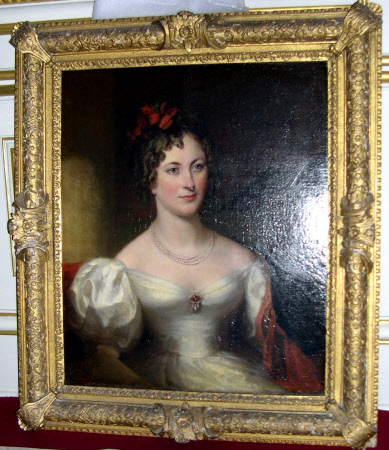Amelia Sophia Hume, Lady Brownlow (1788-1814)
attributed to John Rising (1753 – London 1817)
Category
Art / Oil paintings
Date
circa 1810 - 1817
Materials
Oil on canvas
Measurements
737 x 610 mm (29 x 24 in)
Place of origin
England
Order this imageCollection
Belton House, Lincolnshire
NT 436041
Summary
Oil painting on canvas, Amelia Sophia Hume, Lady Brownlow (1788-1814), attributed to John Rising (1753 – London 1817). A half-length portrait of a young woman, turned slightly to the right, gazing to the right, seated wearing a white dess and red wrap with a ruby broach and pearl necklace. Amelia Sophia Hume was born on 31 July 1788. She was the younger daughter of Sir Abraham Hume, 2nd Bt (1748/9-1838) and Lady Amelia Egerton (1751-1809). She was baptised on 11 September 1788 at Wormley, Hertfordshire, England. She married John Cust, 1st Earl Brownlow (1779-1853), son of Brownlow Cust, 1st Baron Brownlow of Belton (1744-1807) and Frances Bankes (1756-1847), on 24 July 1810 at St. George's Church, St. George Street, Hanover Square, London, England. She died on 21 February 1814 at age 25 at Belton, Lincolnshire, England. She was buried at Belton Church and is commemorated by Antonio Canova's monument. She died before her husband became 1st Earl Brownlow. John Rising is better known as a copyist of Reynolds’s works (two copies of Reynolds’s Self-portrait, and of his Robinetta, were in Sir Abraham Hume’s collection (1824 Cat., nos. 141 & 142), and later at Belton than as a portrait-painter in his own right, but the examples of his independent portraiture (for example at Stourhead), together with the known fact of his employment by the sitter’s father, make the attribution of this portrait to him not implausible.
Provenance
Purchased with a grant from the National Heritage Memorial Fund (NHMF) from Edward John Peregrine Cust, 7th Baron Brownlow, C. St J. (b.1936) in 1984
Credit line
Belton House, The Brownlow Collection (acquired with the help of the National Heritage Memorial Fund by the National Trust in 1984)
Makers and roles
attributed to John Rising (1753 – London 1817), publisher previously catalogued as attributed to The Hon. John Collier (London 1850 – Hampstead 1934), publisher

